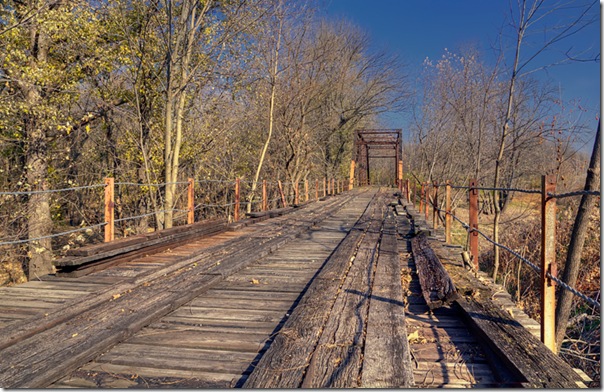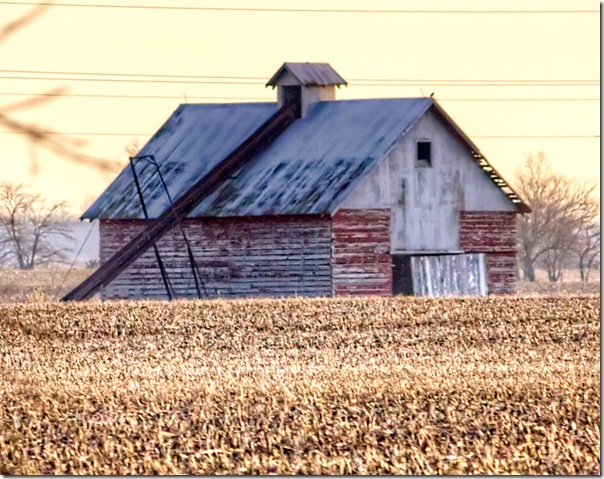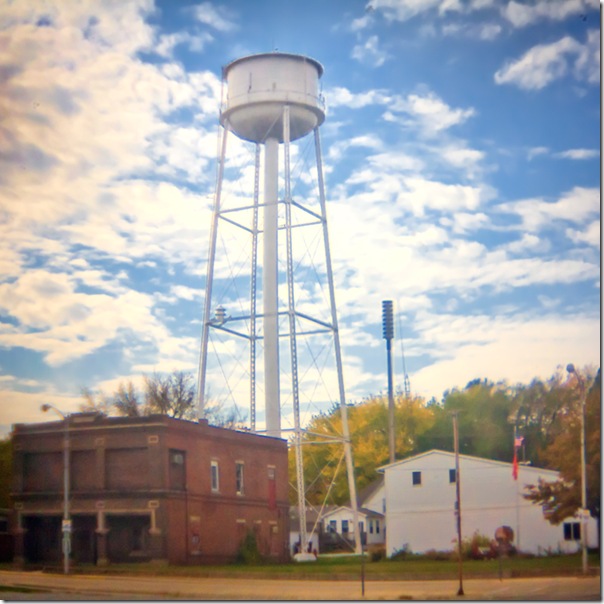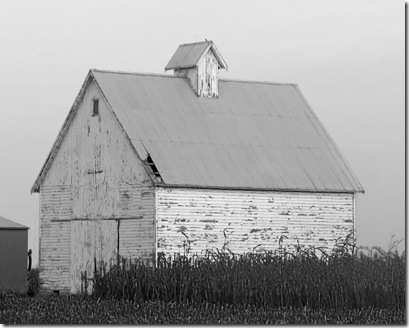Hazen Bridge
Built in 1893 the Hazen Bridge is located north of Mahomet, Illinois. It has been closed to vehicle traffic for at least twenty years. Amazingly, when a new bridge was built just slightly to the south the Hazen Bridge was preserved. The unusual thing about this bridge is the long approaches over a suspended wooden plank roadbed.
I can say from personal experience that crossing this bridge in a car got your attention. I have crossed a lot of bridges with a wooden plank roadbed, however the length of this bridge was unique in my experience. So while most of the old truss bridges are now gone I am glad that this remarkable example is still here. I took some photos there a while back and just got around to doing something with them.
Corn Cribs
I have the habit when on trips of taking pictures out the car windows. Not the best way to get a good image, however it is something to do. Out in the open farm country corn cribs make a good target. There are still a lot of them around, however most haven’t received much upkeep in many years. You would have to be in your 50’s to have seen a corn crib being used for what it was intended. And that was to store ears of corn until they were dry and ready to be shelled and taken to the grain elevator. That practice stopped in the 1960’s and corn cribs have been without much of a use since then.
The image above shows what around here was called a corn dump. I don’t see many of these around. And most of the ones I do see are like the one in the photo. Rusting away while still in place next to the corn crib that it once served. The Corn dump lifted the ears of corn to the top of the corn crib where the corn was directed by shoots to the bins on either side of the corn crib. I imagine it was a pain to have to climb up to the shoots when it came time to move them.
The metal grain bins on both sides of this corn crib are what has replaced the corn crib. They store shelled corn and usually have some means of drying that corn. Some people tried to adapt corn cribs to holding shelled corn, however that doesn’t seem to have worked out too well. Although I can see why it would be tried. I imagine some farmers had invested a fair amount of money in building a corn crib and didn’t want it to become useless. Unlike barns most corn cribs were not that old by the time that shelled in the field corn came along. The need for large corn cribs didn’t come up until yields increased greatly with hybrid corn in the 1930’s. And corn cribs were still being built at a fairly quick rate in the 1950’s and early 1960’s. Just in the small area that I grew up in I can remember a few large corn cribs going up just a few years before field shelled corn put them out of a job.
A lot of people who have no way of knowing better call corn cribs barns. However a corn crib is a much more specialized building than the traditional barn and has a different history. Hopefully here I have enlightened a few about corn cribs.
Villa Grove, Illinois
A while back I took some pictures in Villa Grove using a Holga lens for a digital Canon camera. I misplaced them on my computer and only just came across them today while I was looking for something else. Still this post is more about Villa Grove than about a lens. The image of above is of the old water tower in Villa Grove. To me at least if there is any icon for Villa Grove it is that water tower. The brick building in front was a library and then was the police station. Currently I believe it is slated to be torn down.
Villa Grove is a town of 2500 around 20 miles south of Champaign-Urbana IL. Villa Grove came to be the town it is today just after the start of the 20th century when the C&EI railroad decided to build shops there. The downtown and most of the older housing in Villa Grove came to be as a result of the C&EI shops. The shops closed down sometime in the 1950’s when the C&EI switched to Diesel power.
Villa Grove continued to have a healthy downtown up until the 1970’s. The building here was once a bank. I think it is vacant now. On this corner the City of Villa Grove once placed a Christmas tree in the middle of the street. When I was a kid it seemed like it was a tradition that someone would get drunk and drive their car into the tree. Once the Christmas tree crasher was said to have been one of the teachers at the local high school. Nobody seems to have taken this very seriously at the time.
The sign is off the Gem Theater, however it was open until recently and there is a possibility that it may open again. I can remember times in the 1960’s when people lined up around the block waiting to see a movie here.
This was Roy French’s barber shop when I was a kid. I probably got my first haircut here. I remember there was a box of toys and comic books for kids.
A typical residential street in Villa Grove. Most of the houses in Villa Grove are ordinary in size. There isn’t a section of the town where there are larger houses that the better off people lived in. Just looking at the houses Villa Grove appears to have always been fairly solidly middle or working class.
Picking Corn
I decided to start the new year by reviving this blog. Since many of my old posts here were things about farming as I remember it as a kid growing up in the 1960’s I figure a good starting point is what I was reminded of while at the Parke County IN Covered Bridge Festival last fall. The photo is of an attachment that was once added to a tractor to pick corn. I remember my father using something like this back in the early 60’s. It could pick two rows of corn at a time. There was a shoot with a conveyor in the back that moved the corn to a wagon attached to the rear of the tractor. I remember the tractor that my father used was a John Deere. When the wagon was full he would use another tractor to pull the wagon to where it would be unloaded. I remember that the tractor he used for that was an International Farmall like the one in the photo.
As I remember the wagon he used looked exactly like the one in this photo. I saw both the wagon and the corn picker in a building that was part of the attractions at the CBF. I ended up converting both images to B&W because the lighting in the building made a horrible color cast that I could not get rid of. Today this the corn picker and especially the wagon look like ancient history even to someone like me who remembers when they were commonplace and state of the art. And I imagine they seemed like a wonder to farmers who grew up picking corn by hand. Still even with these aids corn harvest was a long process. I remember that in the fall harvest occupied all of my father’s waking hours for weeks at a time.
Once the corn was picked it was placed in a corn crib. Corn cribs are often identified as barns, however they were a specialized structure used for the purpose of drying and storing corn back in the days when corn was harvested as a whole ear, instead of being shelled in the field as is done today. There was a conveyor called a corn dump which went to an opening at the top of the corn crib. The corn was raised to the top of the corn crib and then directed by shoots within the crib to the bins within the corn crib. So all of this was quite a bit of work. Picking corn two rows at a time, then taking it to the corn crib and dumping it. The corn crib in this photo was one of the last types of corn cribs to be built. I actually remember it being built in the early 60’s. It was only used for a few years until it was made obsolete by corn pickers that would shell the corn in the field.
In one of my old blogs I described in some detail the process of using a corn crib as I remember it. I don’t think that post is online anymore. Hopefully I can find that post and recreate it here. Today when I see the huge combines and trucks that make fast work of harvest I wonder how primitive the harvest of just what seems like a short time ago must seem.
So here is this blog alive again. Looks like I haven’t posted here in over two years. As some may know I have been doing a photography blog, however I have been getting a renewed desire to do a more general blog. Maybe I will even offer some opinions which is something I have been avoiding for a while.
Billy Williams is traded
While looking at an old paper from October 25, 1975 I saw an article about Cub Player, Billy Williams, being traded to the Oakland A’s. The main thing I noticed about the story is that it said that Williams was happy for the trade because it meant that he had a chance to be on a pennant winner. Oakland had won just won its third World Series in a row so William’s optimism was well-founded. Still as it worked out Oakland failed to win a pennant in 1975, being swept by Boston in the ALCS. After that, Oakland did not reach the World Series again until the late 1980’s. Williams was long retired and in the Baseball Hall of Fame by then.
Hard Roads
The lighter side of the road in the photo is one of the few parts left of what was one of the original hard surfaced roads in rural Champaign County. The road was built in the 1920’s as part of a project to connect all of the towns in the county with hard roads. At first there was no asphalt side as seen on the right. Instead when a vehicle meet another each would have to partly get onto the softer shoulder. I imagine that this road was somewhat of a marvel in its time. Before these roads travel could often be difficult because of mud. It seems that in the days of horse travel that people could cope with this limitation, however once motorized vehicles became common they no longer wanted to be limited by the mud seasons. Now these roads were not happily greeted by all. There were often major protests against these roads in the rural areas. Many foresaw correctly that these roads would help to forever change rural communities. Some also didn’t like the fact that the roads would be difficult for horses which were still important in the agriculture of the time. Still as happens most of the time enough people were enthralled to the idea of progress to make these hard surface roads inevitable.
When I was a child this road was still called “the hard road”. Sometimes this seemed funny to me since by my time most all the roads were hard surfaced. One odd thing about this road is that even after the asphalt part was added, most people still drove on the concrete part no matter which way they were going. When you would meet another car you would yield to the asphalt part if that is the side that you should have been driving on. I can remember that there was sometime a bit of drama about who was going to yield, however I never heard of any accidents. I remember this was still the practice when I first started driving in the 70’s. Sometime in the mid-eighties this road was resurfaced into a conventional two lane road between highway 130 and 45. The remnant in the photograph survived because the original road took a less direct route to 45 passing through Pesotum first. I would say that the people here got pretty good value out of these roads. Most of them remained in decent shape for over 50 years. Anyway if you ever come across a stretch of road that looks like the one in the picture you will now know what you are seeing.
Corn Sheller
The picture is of a machine that is used to shell a single ear of corn. The ear of corn goes to the opening on the top. Then you turn the wheel on the side. The corn comes out at the bottom and the corn cob comes out through a slot at the front. It may not look like much, however it is a wonderful piece of machinery. The wheel at the side still turns easily and it does not require much in the way of strength or effort to operate. I image that it could get tedious to shell a lot of corn with this, however it would not be physically tiring.
As I am writing this I realize that I have never asked anyone who was old enough to know how this machine was used on a working farm. I doubt that it was used to shell an entire crop of corn. More than likely it was used to shell small amounts to use as needed for feed. I suppose I should ask someone soon since there likely aren’t many old farmers still around who remember.
I found another use for this machine in husking black walnuts. I drop the walnuts in the top and the husks comes out on the bottom and the nut comes where the corn cob does. It definitely beats stomping on the husks or driving a car over them. Although most years I still leave the black walnuts to the squirrels. I imagine that I may be lazier than my ancestors. Or at least I am not compelled by necessity to work so hard for my food.
Grain Elevator
In most of the rural Midwest a grain elevator like the one in the picture are the tallest thing around. When the railroads first came to this area their main purpose was to ship agricultural products. Stations were established about every six miles on the new railroads. The six mile spacing was dictated by the limitations of how far farmers could haul their products in the days of horse farming. Today in Central Illinois if you drive a road that runs beside a railroad you may notice that there is a town or at least an attempt at a town about every six miles.
I would guess that most people today have no experience of what a grain elevator is used for. At the most basic they are used to store the grain that farmers bring in until it is sold and shipped. My experience with elevators is that of having helped my father harvest his crops. Most of the time I would wait in the field while a truck was filled with grain. I remember reading a lot of books while I was waiting. Once the truck was full I would drive it to the elevator. Generally we used an elevator that was three miles from the field. When I came to the elevator my first stop was on a large concrete pad which was part of the scale that would weigh the truck when it was full. The truck would again be weighed after dumping the grain and that would determine how much grain was in that load. While on the scale a probe would be lowered to take a sample of the grain. The sample was used to tell how wet the grain is. Grain needs to be at a certain moisture level before it can be stored. Most of the time the grain from the field is too moist so it must be dried. By taking the moisture level when the grain comes in the elevator knows how much to charge the farmer for drying.
The weighing and the probing is done by a person in a building next to the scale. My main memory of this experience is craning my neck to look back to the wave of the hand from the person inside the house that meant that I could move forward and dump my grain. The grain was dumped in what looked like a long garage inside the actual elevator. There were metal grates on the floor where the grain that came out of the shoot at the back of the bed of the truck would go. Sometimes there was more than one grate so you had to pay attention to the guys in the elevator to make sure you stopped at the right one. Once you were in place all you had to do was to raise the bed of the truck and let the grain pore out.
Inside the elevator was very loud and dusty. Part of the noise was due to the activity for which the elevator gets its name. After the grain was dumped it would be elevated to shoots at the top of the elevator and moved to a bin. If the grain was too moist it would be moved to a bin where the grain would have warm air blown through it to dry the grain out. The dust in the elevator was came from the dust in the grain. Corn seemed like it was the worst one for having a lot of dust. The dust didn’t seem to bother most of the guys that worked inside the elevator. I seldom remember seeing any of them wearing dust masks. I even remember seeing one guy smoking a pipe while he unloaded the grain. This was before it became common knowledge that grain dust could be pretty explosive stuff and smoking was banned inside elevators. I guess we are lucky that we didn’t get blown up.
So there isn’t a lot more to it. I don’t remember any drama or even minor stories from the days when I was taking grain to the elevator. It could be very pleasant driving back and forth on a lovely fall day. Sometimes it was a strain when we started around dawn and didn’t stop till well after dark. Still I thought that maybe a few people might be interested in knowing what goes on in these rural icons.
Christmas Lights and Thanksgiving
I used the time that I was going to make a post yesterday to put up some Christmas lights. I think I do this mostly in hopes that there will be snow and I can enjoy the reflections of the lights on the snow. I suppose another reason is that I have a couple of nephews who are still young and who enjoy such things. It is probably good for them to have some memories of their uncle doing something normal.
This being a holiday week I find that I don’t have a lot of ambition. Although I don’t require much inspiration to take things easy. Anyway I would like to wish a Happy Thanksgiving to anyone who should come upon this page.

























